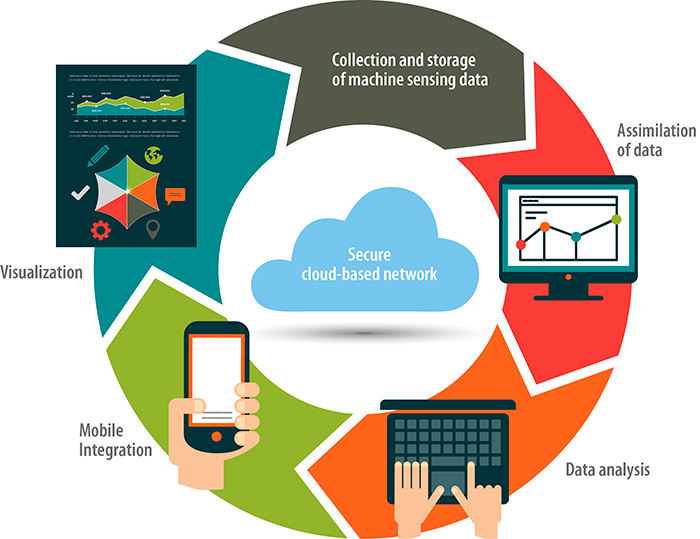The term the Internet of Things (IoT) has grown in usage, both within the business world and society as a whole. But for many people, the concept is unclear. The phrase often means different things to different people.
In simple terms, IoT is the concept of connecting any device with an on/off switch to the Internet and other devices. Because of the declining costs of sensors, connectivity and processing power, enterprise adoption of IoT is gaining significant momentum.
 Figure 1. A whole-product solution (Courtesy of Accudyne Industries)
Figure 1. A whole-product solution (Courtesy of Accudyne Industries) A recent study by ABI Research forecasts massive growth in IoT adoption across industries, with the number of business-to-business IoT connections rising to an estimated 5.4 billion globally by 2020—roughly four times what it is now.
While this vast network of interconnected devices is often associated with consumer goods such as cellphones and automobiles, the adoption of this concept is spreading to many industrial arenas, including pumps and metering technologies—also known as the Industrial Internet of Things (IIoT).
The integrated sensor technology and network connectivity afforded by an IIoT architecture can link individual pieces of pumping equipment, or an area-wide group of pumps, to a cloud platform. Such connectivity provides real-time, password-protected data access to anyone with an Internet connection from anywhere in the world. By collecting and migrating this data to a Software-as-a-Service (SaaS) platform, the user can perform real-time, historical and predictive analytics.
To deliver a fully connected pump management system that affords real-time, predictive analytics, developers must answer three questions about any proposed IIoT architecture.
1. How "smart" do the pumps need to be?
Industrial plants must make informed decisions about the type of hardware that will be required—from sensors and controllers to protocol-agnostic intelligent gateways—to link each pump, valve or related piece of equipment to the Internet.
2. How will the pumps be connected to the Internet using a cloud platform?
Will this platform be developed, owned and operated in house, or licensed from a third party such as Google or Microsoft's Azure cloud services? An important consideration related to the choice of cloud platform centers is the software that will be used to track, analyze, interpret and report the vast quantities of data that will be generated. Does the developer plan to package and provide software via an SaaS offering to clients, or will the software simply be used as a means to deliver predictive analytics and reports?
3. How will the facility keep data secure?
With so many devices—many with multiple sensors and controllers—streaming data into the cloud, how will developers ensure that the information remains secure? While many cloud platforms have robust cybersecurity measures built in, new threats frequently arise that require additional levels of protection. Developers must choose the level of security that makes the most practical and economic sense for their application. For example, does a single pump require the same level of security as a larger, more mission-critical systems control network?
With a common platform in place that addresses sensing hardware, connectivity and security, the developer can then shift to managing the assets—individually, as a group or both. At the single pump level, the IoT concept allows the end user to remotely monitor pump activity by reviewing the real-time sensor data streaming into the cloud-based software, which displays pump readings through a dashboard interface.
If a sensor detects a problem with the pump—for example, a diaphragm material that becomes too thin or a motor that begins to draw a higher amperage—a signal alerts the user on his or her office computer or smartphone.
The user can then review all pump information in real time and assess the cause of and solution to the problem. The plant can quickly deploy personnel to the pump to confirm the problem and make the appropriate fix before the pump fails completely—a predictive maintenance solution that keeps costs and time to a minimum while making more efficient use of personnel.
The IoT concept has led manufacturers to be unsatisfied with selling just a single component to the end user. Instead, they are beginning to take more ownership of the full system by providing multiple components that improve the operating efficiency of an entire process.
This whole-product concept may have far-reaching positive implications for both the manufacturer and the end user. For example, a large tractor manufacturer several years ago began a program of using sensors to monitor the operation of its tractors.
The company soon realized that if they were properly configured, these same sensors could measure moisture content in the soil. Tying that data into weather forecasts, the manufacturer could generate reports that help farmers decide which days of the month are best for planting a given crop. By embracing the power of the IoT as a true whole-product solution, the company opened previously undiscovered business opportunities.
In the same way, the IIoT can offer new opportunities beyond merely providing smarter pumps. It could enable better predictive analytics and preventive maintenance to help end users fix pump problems before failures occur. Also, the IIoT's data analytics and reporting provide pump manufacturers with more detailed information about the operation of their systems in the field, which could benefit product development.
If the reporting suggests common modes of failure or design flaws, manufacturers can proactively make changes to eliminate these problems and deliver better-performing pumps—often before they even hear a complaint.


